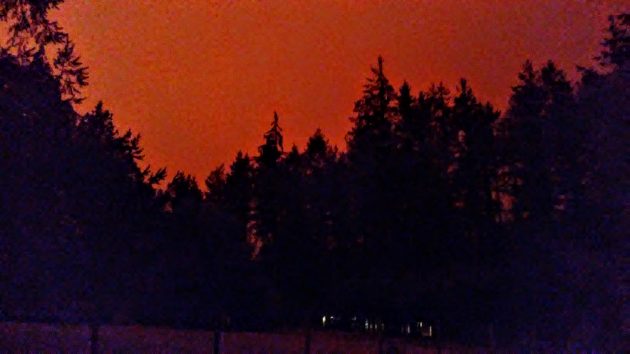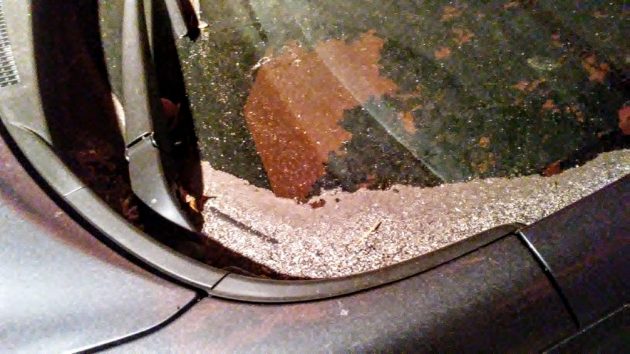
The sky northwest of Albany an hour after sunrise this morning.
The sun must have risen at 6:45 this morning, as scheduled. But in the Albany area we didn’t see it because of the covering of smoke from the wildfires spreading in the hillsides and canyons to the east.
We still didn’t see it at 10. Everything outdoors was shrouded in a menacing dark, with the sky glowing red overhead.
Not in living memory — my memory, anyway — has wildfire smoke affected the mid-valley in this way.
And there was ash, seemingly plenty of it, judging by the amount that had accumulated on the windshield. We haven’t had that around here for 40 years, not since Mount St. Helens blew up in May 1980.
As you’ve no doubt heard, evacuations have been ordered in the North Santiam Canyon, and people in east Linn County have been advised to stand by in case they have to leave as well. For updates, check the Facebook pages of the Linn and Benton County sheriff’s departments.
Fire, smoke and ash — that’s all, in addition to everything else, that 2020 needed to warrant being called one of the worst years in a long time (hh)

By this morning, a drift of ash had accumulated on this windshield.


At 2:00 the PM2.5 hit 651 micrograms per cubic meter (Calapooia Middle School) — off-the-chart high. I imagine that’s when the ash landed. By 7:00 it was only a tenth as bad.
For those who follow such things, the Albany PM2.5 readings were missing much of the night but are now complete. Seems that the sensor was working but maybe communication wasn’t.
I felt like I was waking up on the set of “Total Recall” or “The Martian.”
Cheech and Chong too.
I track this website for grins-
https://www.wunderground.com/dashboard/pws/KORALBAN93/graph/2020-09-8/2020-09-8/daily
You can compare solar readings to previous days.
I’d noticed some ash a couple days ago, now that I know what it is. A lot more this morning collecting on the spider webs.
The orange to yellow was pretty eerie too.
That station looks like a pretty good one. The wind readings are higher than many, probably because the sensor is high enough. I’m surprised that the solar ratio is only about 3/1 (normal/today), seemed darker than that.
The sun emits light in a wide spectrum of wavelengths. Many invisible to us, but not solar panels.
Different “particles” in the air may block, scatter or auto fluoresce the various wavelengths of light differently from other wavelengths. (Do you see UV?)
I used to build optical oceanographic instruments, so a bit of the science stuck.
As far as your other comments about readings being delayed- That’s called a “time constant”. If for example, a digital voltmeter didn’t have a TC, the last digit would always look like 8, because it’d be changing so rapidly due to RF etc interference. A longer TC “smooths” the data. An example is to compare the airport plot vs the one I posted. Notice it’s much smoother because it has a longer TC. Something like an air pollution monitor would TYPICALLY experience slow changes, so it would have a longer TC just to avoid/reduce “spikes” in the data. Think of somebody walking by a monitor and exhaling a cig…..It would be meaningless to the average, but could give a relatively enormous spike on a “clear” day.
Bill, good point about spectral mismatch between the human eye and photo sensors (silicon solar cells or otherwise). Solar cells respond well to near infrared. Humans can’t see it, and (I’m guessing) more of it gets through smoke than does visible light via the mechanisms you describe.
I assume your comment about time constant refers to the previous story where I said:
“””… the AQI is some kind of “algorithmic” running average of the current PM2.5 reading (itself a 1-hour average) and some previous readings … It works badly if you just want to know conditions RIGHT NOW. That “moderate” (yellow code) reading was deceptively low because of the sudden onset.”””
I agree about time constant. “RIGHT NOW” was a really bad word choice. I meant wanting a number that smooths only the last hour (like the PM2.5 reading), or better yet: 10-15 minutes, not multiple hours like the AQI and its color codes.
By the way, Corvallis is twice as bad as Albany today. The Oregon DEQ website worked sometimes and always very sluggishly, but was up-to-date. The fire.airnow.gov website (which I praised yesterday and still works well) is not current and misses some recent data, same as the EPA database which aggregates data from many DEQ-type sources.
I can’t speak for dirty air, but in water, the “higher” wavelengths such as IR were the most attenuated. We know you can get a sunburn from UV (a “lower” wavelength) even when cloudy. Chlororophyll A autofluoresces a wavelength of about 660 nanometers when excited with a wavelength of about 480 nanometers. A lot of odd things happen between different substances & wavelengths, or the same substance and different wavelengths.
Here’s a link on the fires from NASA. Heavy use, it may be slow to load…
https://firms.modaps.eosdis.nasa.gov/map/?fbclid=IwAR1GBlrDeCv2YXxBGScLZHKIcjYtZ_QWYBJAcg6X1R_GTwGcPunxQL4byXI#d:2020-09-07..2020-09-08;l:countries,street;@-122.5,44.7,10z
Thanks, neat map. Website says: “Due to heavy traffic please consider using”:
https://firms2.modaps.eosdis.nasa.gov/map/#d:2020-09-08..2020-09-09;@0.0,0.0,3z
This link will work better than either one above, because it defaults to “last 24 hours” instead of sometimes missing parts of the world:
https://firms2.modaps.eosdis.nasa.gov/map/
For those old enough to remember field burning in the Willamette Valley this is like putting a whole season of burning in one big container and keeping it locked.
Hang on Pray for rain and keep safe and healthy
I swept up a big container of the ash to make commemorative 2020 Christmas tree ornaments with. It will be an appropriate symbol of this calamitous year.